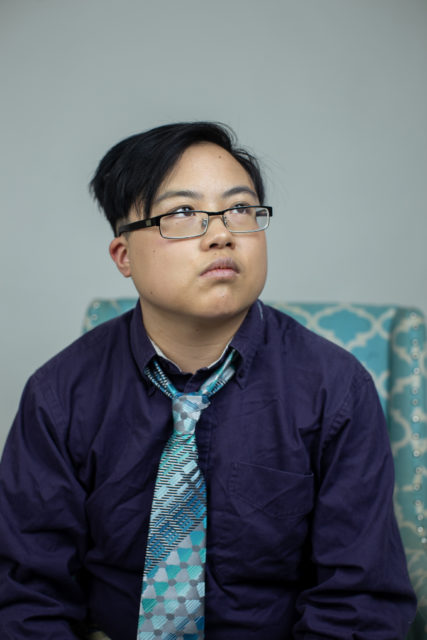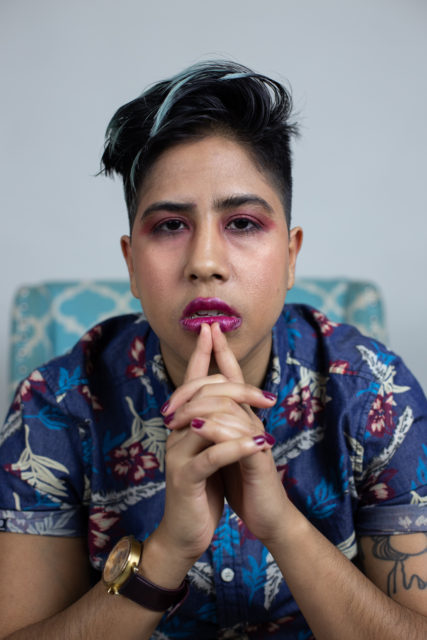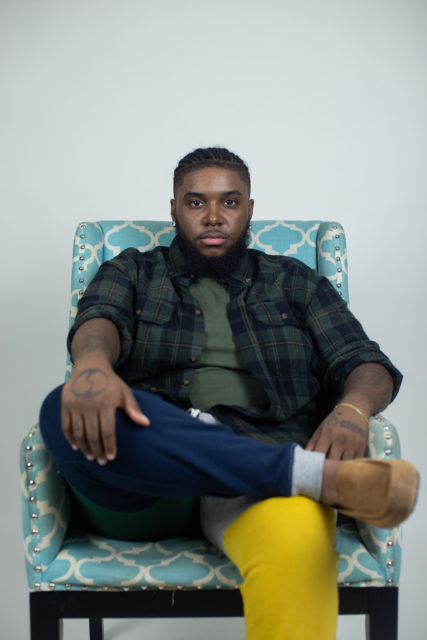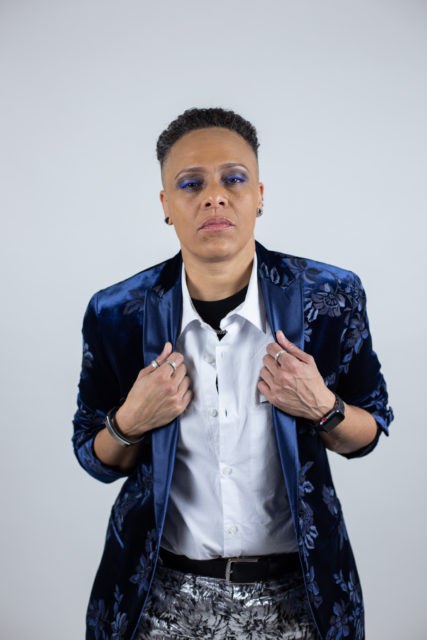Representation matters. It matters for the queer kids of color growing up right now, not knowing if their gender exploration is valid. (It is.) It matters for young Black trans women who only see trans identity talked about when violence happens. It matters because our communities deserve to have our stories told in a way that explores the beauty of our lives and our loves. The expansiveness of identity within the LGBTQ community is what makes us so strong. Directors and producers Tina Colleen and Monick Monell hope to show just that with their new documentary I Identify as Me, coming out in 2019.
As we all await the premiere of this needed documentary shining a light on QTPOC masculine of center and GNC lived experiences, GO wanted to sit down and get to know the cast a bit more. We talked with them about the process of making this film and why they believe representation is needed.
GO Magazine: What has the process of the documentary been like for you?
Charlie Trotman: This documentary has been illuminating. The documentary initially felt like a light at the end of the tunnel, but then as we filmed, I began to realize that it was still dark out in the world for folks who are like me, so I had to set myself ablaze and become the light itself so that other people could see themselves too. I had to become what I was looking for and now I get to share it with other people in a different way. I feel like for one of the first and few times, there is a full and up to date expression of masculinity in non-male folks. Masculinity is a spectrum, as is gender, and it’s important to give light and do justice to the representation of both.

Chayse Attah: For me, the process during this documentary has been amazing. I have met so many beautiful people and made a connection, which I never would’ve thought would happen.
Frankie Classe: The process has been really fun and evolutionary for me. It was such a great opportunity to explore the depths of the different facets of my gender expression by being comfortable in front of the camera. I was able to be vulnerable and strong and really appreciate the different sides of me. So often we show one version of ourselves to the world, it was nice to let them all hang out, my most honest self.
Lydia X. Z. Brown: It’s my first time participating in a film project like this, and when I first agreed to join the cast, I didn’t know what to expect. In the last several months, I’ve had so many incredible opportunities to be in community with fellow queer trans people of color, which is a huge contrast to so many spaces I find myself in on a daily basis working in law and policy. The creative energy and intensity when we’re all in one apartment are phenomenal.

Meek Jaffe: The process of this documentary has been a fun, energetic, powerful, humbling and an educational experience for me. I’ve learned so much about my fellow cast members and myself that I get to take with me for life, and I feel gifted to be able to. I didn’t know what to expect walking in, but when I finally did, I walked around and had a seat. Everyone was amazingly comfortable, and I was truly honored to share the space of privacy and intimacy with them. The crew has been one of the most supportive crews I’ve had the pleasure of working with; Monick and Tina [Directors/Producers] made this experience a memorable one.
Monick Monell: It has fulfilled my many busy days, but the documentary has opened my eyes in many ways, which I don’t speak much about in my daily life.
Neha Ghosh: The entire process has been very interesting and very much a learning experience for me. This project has been going on for close to a year now and in that time, I feel like I’m constantly learning more about myself. When we shot my piece of the documentary it challenged me to think more about who I am, how I think, and how I can unlearn certain things too. I have very much enjoyed getting to know the rest of the cast and realizing how similar and different we are all at the same time. Watching the process unfold has been quite beautiful.

TJ Love: The documentary has been nothing short of a learning process. It has pushed me to grow exponentially from the very start. I never talked about my sexuality freely or on any large platform before. Only a very small circle of people knew I was sexually fluid. I had to digest the idea of talking about it publicly and the judgment or backlash that may come along with talking about it. I even considered walking away from the documentary because of my discomfort with speaking about the topic. I had to love myself more, respect myself more, and trust myself more to move forward with it. Tina [Director/Producer] was a huge help. Finally explaining myself to my family and more friends was a huge help as well.
GO: Why is it important for the community to see this representation?
Charlie: We represent what happens when you remove the box of gender and even racial norms while still orbiting around masculinity at the center. Even when there is representation of gender nonconforming (GNC) or masculine of center people, they’re typically someone who’s slim or toned, very physically androgynous and white or light-skinned. It’s rare to see people like myself or the other cast members in most places. We end up on memes or just not seen at all.
I love that femininity has become more highlighted and that it is breaking out of its norms, but there are still far fewer examples of masculinity on the gender spectrum, especially when it comes to transgender and GNC people.
Chayse: It is coming from the people who actually live this life on a daily basis; it is authentic.

Frankie: It shows the diversity and individuality of gender expression. People stereotype what queer and GNC people look like. It’s important the world sees the different forms of representation and individual stories that make our experiences unique.
Lydia: I’ve spent much of the past decade deeply entrenched in movements for disability justice and neurodiversity, finding myself far too often in white, straight, and cis dominated disability spaces—even in spaces ostensibly meant to center disabled people of color and queer and trans disabled people.
When queer and trans disabled people of color need a space to simply be our authentic, full selves, let alone to organize, create, and agitate together, the onus is always on us to build those spaces because we know dominant cultures, even within marginalized communities, will never do it for us.
Being part of this documentary means that I am contributing to a beautiful offering from our communities to our communities, as a reminder that we are out there, that we deserve to exist and to flourish, and that we are doing amazing things no matter what is thrown at us.
Meek: Because we ARE the community. We are the many faces walking to work, to school, home, and with our families. We are the community advocates, we are the disenfranchised, the forgotten, the misunderstood, and most importantly we are the voice. If not us, then who?

Monick: I feel there isn’t enough authentic representation of queer trans people of color (QTPoC) as us being ourselves. Most of the time we have someone who turns the story around about our lives for ratings or marketing. This time, we have control over our narrative and how it enters the world. Furthermore, both the cast and crew are QTPoC, which is extremely rare.
Neha: It’s important to me as a South Asian nonbinary queer person to show that there are South Asian queer people out here thriving. There has been very little (maybe none?) mainstream media representation of queer South Asians. We have had to take to other means, such as Instagram, Tumblr, Facebook, and publications of the like to find the representation we’re craving.
Art and media in the U.S. are racially binary which makes South Asian folx feel unseen, and the added layer of queer identity makes you feel even more invisible. People often say I’m the first queer South Asian person they’ve met, which cannot be true. That statement alone makes me feel isolated. Our South Asian culture turns away from us queers, so we turn to the other communities that we grew up in, instead. This generally means leaning into either whiteness or blackness, neither of which are true to ourselves. It is important to see queer South Asians represented and seen as whole people.
TJ: I think the community has spent too much time conforming to heteronormative ideas. Not every family is going to look like what someone may imagine in their head to be “normal.” We are the margins of the marginalized. I am a black, gay, female who presents masculine and is sexually fluid. It’s a mouthful and a headache, but it’s who I am. I shouldn’t feel like I have to hide it because it’s not what people view as “normal.”

GO: What’s the biggest takeaway you’ve gotten from participating in the documentary?
Charlie: I feel as though I am able to see all the other manifestations of the divine in the other cast members. I get to take away that we not only existed but we as an array of bodies and intersecting identities, exist and for me, it is an act of revolution to come into your own light alongside others. It further proves that we can all be seen and see one another.
Chayse: There are people out in the world who are experiencing exactly what I am. I have learned to be open to sharing my experiences and listening to others as well.
Frankie: Listening to other people who identify as I do and feeling so different from them, but really there are more similarities than differences. Thinking about all of the different backgrounds we represent we have so many similar stories.

Lydia: QTPoC cultural workers, organizers, and leaders are brilliant, innovative, and magnificent.
Meek: I’ve come to understand the many different views on how people see themselves versus how you see them. That perception and reality can either complement or conflict with one another. I’ve learned that love will always be the universal language no matter identity. We are all one species and in order to perpetuate our existence, love is key.
Monick: The biggest take away was how much each cast member’s story touched me. I didn’t just speak about my story but learned and grew so much to respect the cast and how they live and see life.

Neha: That my voice is just one take. No one person can represent all the stories of our people. It is so important to find people that love you and hold you accountable. It is beautiful to see our stories in this medium and see our joy in different ways. I’ve really enjoyed getting to know the cast and crew on a deeper level. The documentary has challenged me to learn more about myself and really dig into how different we all are and how we’ve chosen to represent ourselves in the world.
TJ: A sense of community. There have been numerous times I have felt like an outsider when I am somewhere that is supposed to be a “safe space” for people who look/dress/present similarly to how I do. Meeting and interacting with the cast has given me a sense of acknowledgment of who I am as a person, and I’ve felt that same energy from the other cast members, as well as the amazing folks behind the scenes. There’s no judgment involved; we’re all here to tell our story and share love.
“I Identify as Me” premiere date is yet to be announced, but there will be screenings around NYC, nationally, and internationally in 2019. If you want to stay up to date regarding the premiere, screenings, and events for “I Identify as Me,” sign up for their mailing list or follow them on Instagram.

What Do You Think?